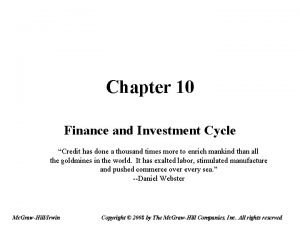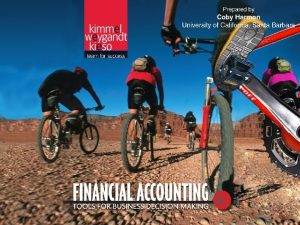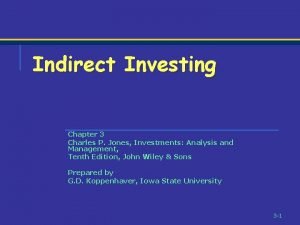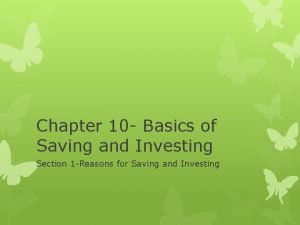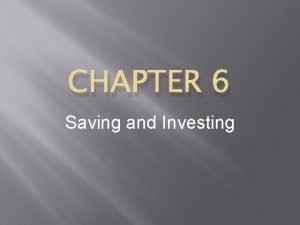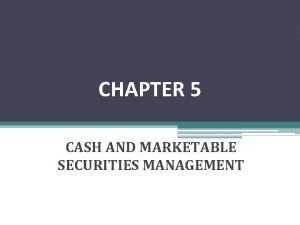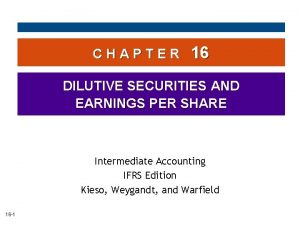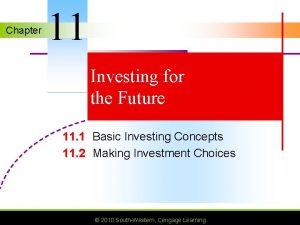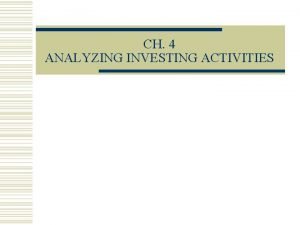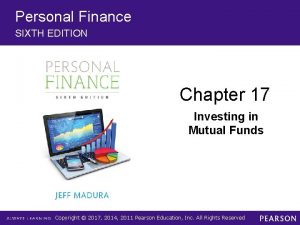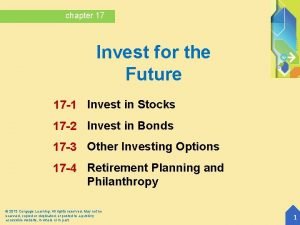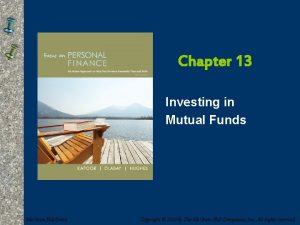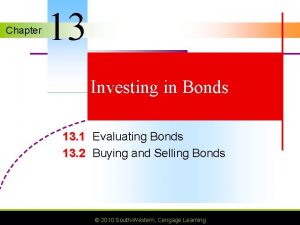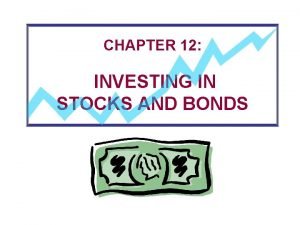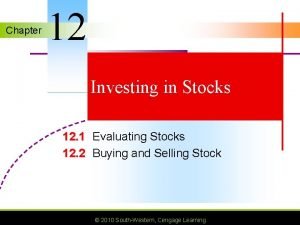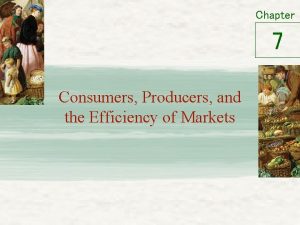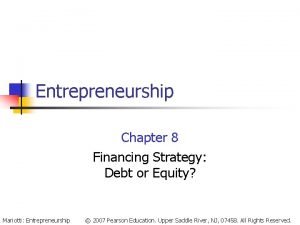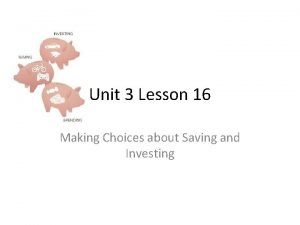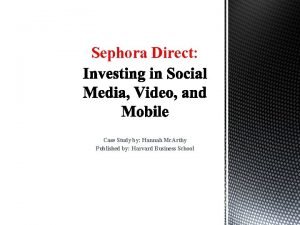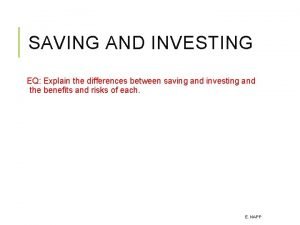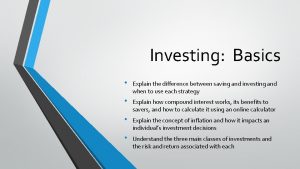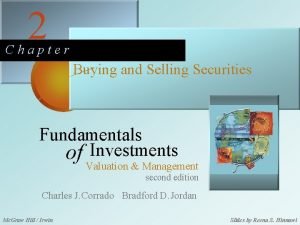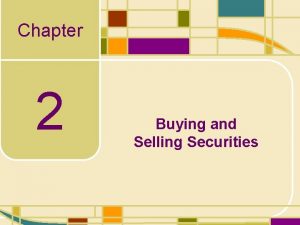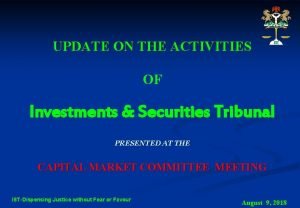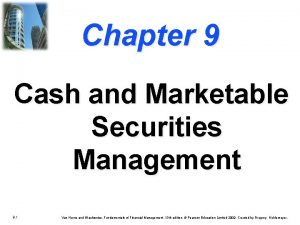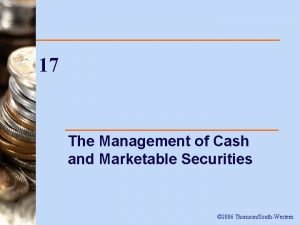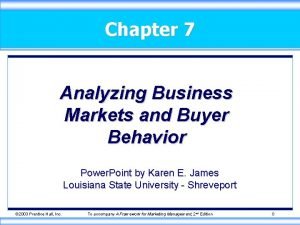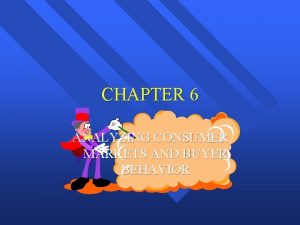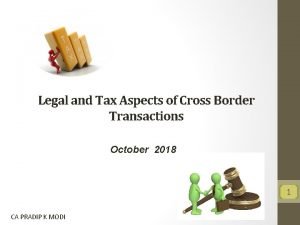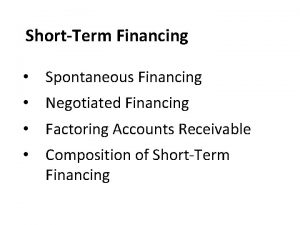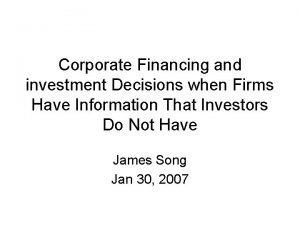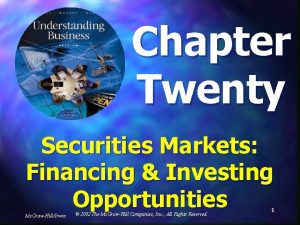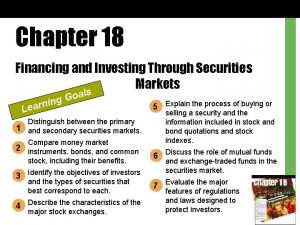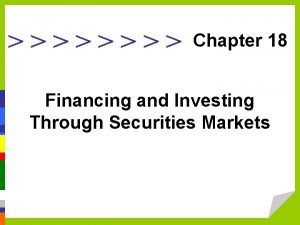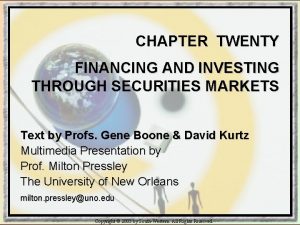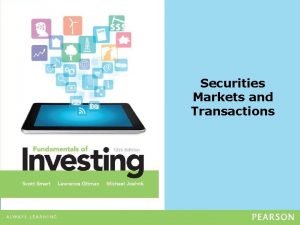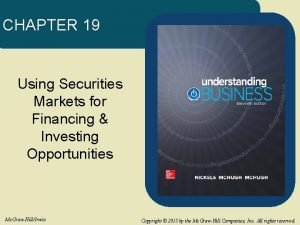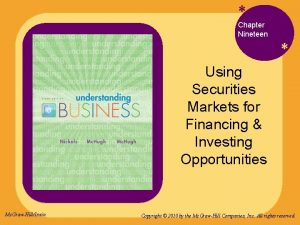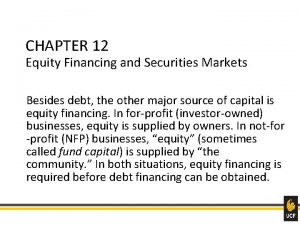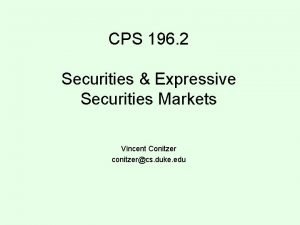Securities Markets Financing and Investing Opportunities CHAPTER 19




















































- Slides: 52

* * * Securities Markets: Financing and Investing Opportunities * CHAPTER ** 19 * * Nickels Mc. Hugh Mc. Graw-Hill/Irwin Understanding Business, 8 e 1 -1 19 -1 © 2008 The Mc. Graw-Hill Companies, Inc. , All Rights Reserved.

* * * Functions of Securities Markets • Long-Term Funding for Businesses • Place to Buy/Sell Securities (Investments) 19 -2

* * * I. THE FUNCTION OF SECURITIES MARKETS Learning goal 1 Identify and explain the functions of securities markets, and discuss the role of investment bankers. A. The Role of Investment Bankers 19 -3

* * * II. DEBT FINANCING BY SELLING BONDS Learning goal 2 Compare the advantages and disadvantages of debt financing by issuing bonds, and identify the classes and features of bonds. A. Learning the Language of Bonds B. Advantages and Disadvantages of Issuing Bonds C. Different Classes of Bonds D. Special Bond Features 19 -4

* * * III. EQUITY FINANCING BY SELLING STOCK Learning goal 3 Compare the advantages and disadvantages of equity financing by issuing stock, and explain the differences between common and preferred stock. A. Learning the Language of Stock B. Advantages and Disadvantages of Issuing Stock C. Issuing Shares of Preferred Stock D. Special Features of Preferred Stock E. Issuing Shares of Common Stock 19 -5

* * * IV. STOCK EXCHANGES Learning goal 4 Describe the various stock exchanges where securities are traded. A. U. S. Exchanges B. Securities Regulations and the Securities and Exchange Commission C. Global Stock Exchanges 19 -6

* * * V. HOW TO INVEST IN SECURITIES Learning goal 5 Explain how to invest in securities markets and various investment objectives such as long-term growth, income, cash, and protection from inflation. A. Investing Online B. Choosing the Right Investment Strategy 19 -7

* * * VI. INVESTING IN BONDS Learning goal 6 Analyze the opportunities bonds offer as investments. 19 -8

* * * VII. INVESTING IN STOCKS Learning goal 7 Explain the opportunities stocks offer as investments. A. Stock Splits 19 -9

* * * VIII. INVESTING IN MUTUAL FUNDS AND EXCHANGE-TRADED FUNDS Learning goal 8 Explain the opportunities in mutual funds and exchangetraded funds (ETFs) as investments, and the benefits of diversifying investments. A. Diversifying Investments 19 -10

* * * IX. INVESTING IN HIGH-RISK INVESTMENTS Learning goal 9 Discuss specific high-risk investments, including junk bonds, buying stock on margin, and commodity trading. A. Investing in High-Risk (Junk) Bonds B. Buying on Margin C. Investing in Commodities 19 -11

* * * X. UNDERSTANDING INFORMATION FROM SECURITIES MARKETS Learning goal 10 Explain securities quotations listed in the financial section of a newspaper, and describe how stock market indicators like the Dow Jones Industrial Average affect the market. A. Understanding Bond Quotations B. Understanding Stock Quotations C. Understanding Mutual Fund Quotations D. Stock Market Indicators E. The Market’s Roller-Coaster Ride F. Investing Challenges in the 21 st-Century Market 19 -12

* * * THE FUNCTION OF SECURITIES MARKETS learning goal 1 Identify and explain the functions of securities markets, and discuss the role of investment bankers. Securities markets are FINANCIAL MARKETPLACES for stocks and bonds. Securities markets serve two MAJOR FUNCTIONS: To help businesses find LONG-TERM FUNDING To provide a place for private investors to BUY AND SELL SECURITIES (INVESTMENTS) such as stocks, bonds, and mutual funds Securities markets are divided into TWO MARKETS: PRIMARY MARKETS handle the sale of NEW securities. 19 -13

* * * Securities markets are divided into TWO MARKETS: PRIMARY MARKETS handle the sale of NEW securities. Corporations make money on the sale of their securities only once, when they are first sold on the primary market. An INITIAL PUBLIC OFFERING (IPO) is the first public offering of a corporation’s stock. SECONDARY MARKETS handle the trading of securities between investors; the proceeds of the sale go to the investor selling the stock, not to the corporation. THE IMPORTANCE OF LONG-TERM FUNDING Many new companies start without sufficient capital, and many established companies don’t adequately plan for long-term financing. 19 -14

* * * Capital Markets • Primary Markets (IPO's) • Secondary Markets 19 -15

* * * Businesses prefer to meet LONG-TERM FINANCIAL NEEDS by using retained earnings or by borrowing from a lending institution. If such forms are not available, the company may be able to raise capital by ISSUING CORPORATE BONDS (DEBT) or SELLING STOCK (OWNERSHIP). These forms of debt or equity financing are not available to all companies. Getting approval for bond or stock issues requires extensive financial disclosures and scrutiny by the SEC. 19 -16

* * * INVESTMENT BANKERS are specialists who assist in the issue and sale of new securities. Investment bankers also UNDERWRITE NEW ISSUES of bonds or stocks, buying the entire issue at a discount then selling the issue to investors. INSTITUTIONAL INVESTORS are large investors—such as pension funds, mutual funds, insurance companies, and banks—that invest their own funds or the funds of others. Institutional investors control over 53% of U. S. stock. DEBT FINANCING BY SELLING BONDS learning goal 2 Compare the advantages and disadvantages of debt financing by issuing bonds, and identify the classes and features of bonds. 19 -17

* * * Investment Banker • Assist Sale/Issue of New Securities • Underwrite issues • Sells to Institutional Investors 19 -18

* * * What is Stock? • Ownership • Certificate • Par Value • Dividends • Common vs. Preferred 19 -19

* * * Stock Advantages • • • No Repayment No Legal Obligation Does Not Create Debt Disadvantages • Voting Rights • Dividends not Tax. Deductible • Management Works to Keep Stockholders Happy 19 -20

* * * Bond Market • Coupon/Interest Rate • Denomination ($1, 000) • Principal • Maturity Date • Classes • Unsecured/Debenture • Secured 19 -21

* * * Bonds Advantages • No Vote • Interest is Tax. Deductible • Temporary Source of Funds • Can be repaid before maturity with call provision Disadvantages • Increase Debt • Legal Obligation to Pay Interest • Repaid on Maturity Date 19 -22

* * * Special Bond Features • Sinking Fund • Callable • Convertible 19 -23

* * * Will Rogers said “It is the return of your money not the return on your money that counts “ 19 -24

* * * Organized Securities Exchanges • New York Stock Exchange (NYSE) • American Stock Exchange (AMEX) • Over-the-Counter (OTC) • NASDAQ 19 -25

* * * Top European Companies by Market Value Source: Financial Times, March 7, 2005 19 -26

* * * Own Stocks? Source: USA Today 19 -27

* * * Investment Criteria • Risk • Yield • Duration • Liquidity • Tax Consequences 19 -28

* * * Investing in Bonds Corporate Bonds Municipal Bonds US Treasury Bonds From 1 to 20 years From 1 to 40 years From 2 to 30 years Taxable Exempt from federal taxes and some state and local taxes Exempt from state and local taxes May be riskier than Attractive to Government backing government bonds, investors in high tax provides maximum but may have higher brackets safety yields 19 -29

* * * Likelihood of Investing In Bonds Source: USA Today 19 -30

* * * S & P’s Top Credit AAA-Rated Companies 1. Automatic Data Processing 2. Exxon Mobil 3. General Electric 4. Johnson & Johnson 5. Pfizer Compared to having 32 Top Companies in the ’ 80 s 6. United Parcel Service Source: Business Week, 2006 19 -31

* * * Investing in Stock • Growth vs. Income • Capital Gain vs. Dividend • • Blue Chip vs. Penny Market Order Limit Order Stock Split 19 -32

* * * Purchasing Common Stock Market Order is placed (and purchased) for the current market price at time order hits trading floor Buyer will not know actual price paid until trade is executed and receives a confirmation 19 -33

* * * Purchasing Common Stock Limit Order Purchase shares at a set price (bid) May or may not get executed if market price (current asked) does not equal bid price 19 -34

* * * Purchasing Common Stock Stop loss order A set sell order to limit loss 19 -35

* * * Long Sale Purchasing stock to hold for the future Traditional stock strategy Assume that the price of the stock will go up 19 -36

* * * Short Sale Sell stock prior to buying it (reverse) Requires that you “borrow” Stock from broker Expectation is for the price to drop 19 -37

* * * Margin Strategy by which you use existing shares as collateral to buy more shares Creates Leverage and magnifies gains and losses Riskier strategy Options Purchase (or Sell) the right to buy the stock at as future date at a set price 19 -38

* * * How Stock Splits Work 100 shares of ABC stock selling at $80 100 shares @ $40 2 for 1 Stock Split Declared 100 shares @ $40 Lower Price increases Demand Increased demand increases price 100 shares @ $45 How Much Profit Has Been Made? 19 -39

* * * Return From Most Widely Held Stock Rank Price One Year Total Return General Electric $34. 66 -2. 2% Microsoft 27. 97 4. 1 Pfizer 21. 35 -21. 0 Exxon. Mobil 57. 38 17. 0 Cisco Systems 17. 37 -11. 1 Johnson & Johnson 63. 34 5. 6 Intel 25. 11 4. 6 Citigroup 47. 94 7. 6 Source: Money, January 2006 19 -40

* * * Mutual Funds • Pool Investors’ Money • Best for Small Investors • Index Fund • Diversification • No-Load vs. Load • Open-End vs. Closed-End 19 -41

* * * Sales of Mutual Funds Worldwide (In Billions) Q 4, ’ 03 Q 2, ’ 04 Q 4, ‘ 04 Q 2. ‘ 05 All Funds $73 $22 $166 Equity 116 75 100 65 Bond -4 -12 43 49 Money Market -67 -58 -10 * Balanced/mixed 23 4 24 26 Other 5 13 8 25 Source: USA Today, 10/16/2000 Source: Investors Business Daily, February 10, 2006 19 -42

* * * Types of Investments Traditional • Stocks/Bonds • Gov’t Securities/CDs • Money Market or Mutual Funds • Real Estate High-Risk • Stock on Margin • Junk Bonds • Commodities 19 -43

* * * Components for Optimal Portfolio Performance • Diversification • Timelines • Safety & Risk • Income & Total Return 19 -44

* * * Do Corporations Provide Enough Information? Source: USA Today 19 -45

* * * How does Buying Stock on Margin work? Step 1 Step 2 An investor wishes to buy 100 shares at $100 per share However, the investor has only $4, 000 available to invest Step 3 Step 4 The investor finds he is able to buy the stock with a 40% margin The investor puts up $4, 000 and borrows $6, 000 from the broker 19 -46

* * * Measures of Investment • Stock Quotations • Bond Quotations • Mutual Fund Quotations 19 -47

* * * Stock Quotes • • • % Change in YTD Price High/Low Price Company Name & Stock Symbol Last Dividend Per Share Dividend Yield P/E Ratio # of Shares Traded Closing Price Net Change- Price 19 -48

* * * Mutual Fund Quotations • Fund Name • Net Asset Value (NAV) • Net Change in NAV • YTD Return • Long-Term Return 19 -49

* * * Original 12 Dow Stocks (1896) • American Cotton Oil • Laclede Gas Light Co. • American Sugar Refining Co. • National Lead • American Tobacco • North American Co. • Chicago Gas • Tennessee Coal, Iron, & Railroad Co. • Distilling & Cattle Feeding Co. • U. S. Leather • General Electric Co. • U. S. Rubber Co. 19 -50

* * * How Much Have They Grown? 1955 2003/2004 S&P 500 45. 48 1126. 21(’ 04) NYSE $207. 7 Billion Mutual Fund Industry 1 Million Source: Fortune, 2004 $17. 8 Trill (’ 03) accounts 250 Mill (’ 03) 100 funds 8, 000 $2. 5 Billion assets $7 Trill 19 -51

* * * What Adults Believe About Wall Streets’ Key Players % Adults That Agree With the Statement Source: USA Today 19 -52
 Finance and investment cycle
Finance and investment cycle Format of indirect method of cash flow statement
Format of indirect method of cash flow statement Operating investing and financing activities
Operating investing and financing activities Direct investing vs indirect investing
Direct investing vs indirect investing Efficient securities markets imply that
Efficient securities markets imply that Chapter 10 basics of saving and investing
Chapter 10 basics of saving and investing Chapter 10 basics of saving and investing
Chapter 10 basics of saving and investing Chapter 6 saving and investing
Chapter 6 saving and investing Marketable securities management
Marketable securities management Diluted eps meaning
Diluted eps meaning The spreading of risk among many types of investments.
The spreading of risk among many types of investments. Chapter 4 analyzing investing activities solutions
Chapter 4 analyzing investing activities solutions Chapter 17 investing in stocks
Chapter 17 investing in stocks Chapter 17 investing in stocks
Chapter 17 investing in stocks Chapter 13 investing in mutual funds
Chapter 13 investing in mutual funds Chapter 13 investing in bonds
Chapter 13 investing in bonds Chapter 12 investing in stocks
Chapter 12 investing in stocks Chapter 12 investing in stocks
Chapter 12 investing in stocks Financial markets and institutions chapter 1
Financial markets and institutions chapter 1 Analyzing consumer markets and buyer behavior
Analyzing consumer markets and buyer behavior Chapter 9 expanding markets and moving west
Chapter 9 expanding markets and moving west Business markets and business buyer behavior
Business markets and business buyer behavior Chapter 5 consumer markets and buyer behavior
Chapter 5 consumer markets and buyer behavior Chapter 5 consumer markets and buyer behavior
Chapter 5 consumer markets and buyer behavior Chapter 9 expanding markets and moving west
Chapter 9 expanding markets and moving west Chapter 9 expanding markets and moving west
Chapter 9 expanding markets and moving west Chapter 7 consumers producers and the efficiency of markets
Chapter 7 consumers producers and the efficiency of markets Chapter 8 financing a business
Chapter 8 financing a business Lesson twelve saving and investing
Lesson twelve saving and investing Unit 3 lesson 2 saving and investing
Unit 3 lesson 2 saving and investing Sephora case study
Sephora case study Explain the investment poem concerning stocks and bonds.
Explain the investment poem concerning stocks and bonds. Saving vs investing venn diagram answers
Saving vs investing venn diagram answers What is buying and selling of securities
What is buying and selling of securities Cisi introduction to securities and investment
Cisi introduction to securities and investment What is buying and selling of securities
What is buying and selling of securities Cash and marketable securities
Cash and marketable securities Investment and securities tribunal
Investment and securities tribunal Sds security services
Sds security services Securities lending and borrowing example
Securities lending and borrowing example What are the functions of securities firms
What are the functions of securities firms Cash and marketable securities management
Cash and marketable securities management Deposit float
Deposit float Marketable securities management
Marketable securities management Chapter 4 cultural dynamics in assessing global markets
Chapter 4 cultural dynamics in assessing global markets Analyzing consumer and business markets
Analyzing consumer and business markets Chapter 18 the markets for the factors of production
Chapter 18 the markets for the factors of production Analyzing consumer markets chapter 6
Analyzing consumer markets chapter 6 Firms in competitive markets chapter 14 ppt
Firms in competitive markets chapter 14 ppt Philippe thiel
Philippe thiel Pros and cons of risk financing
Pros and cons of risk financing Spontaneous finance
Spontaneous finance Corporate financing and investment decisions
Corporate financing and investment decisions
